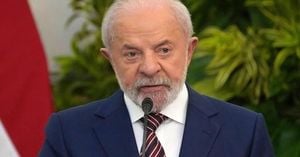Oil prices surged on October 23, 2025, as the United States and European Union unveiled their most aggressive round of sanctions yet against Russia’s oil industry, aiming to further choke off the revenue that funds Moscow’s war in Ukraine. The measures, targeting oil giants Rosneft and Lukoil, mark the first such action since Donald Trump’s return to the White House, and reflect a coordinated Western effort to tighten the economic noose around the Kremlin.
According to the US Treasury Department, the sanctions zero in on Rosneft, Lukoil, and several subsidiaries at least 50 percent owned by these firms. The stated goal? To “reduce the Kremlin’s revenue for its war machine” and “weaken” Russia’s already strained economy. Rosneft, Russia’s largest state-owned oil company, and Lukoil, one of its biggest private producers, together generate more than $200 billion in annual revenue—funds that are widely seen as critical to sustaining both the Russian economy and its military operations.
On the day the sanctions were announced, the price of US crude, West Texas Intermediate (WTI), jumped by about 2.5 percent to nearly $60 per barrel. Brent crude, the international benchmark, held steady at about $63 per barrel. These price movements underscore just how closely global oil markets are watching the standoff between Russia and the West, and how quickly new policy moves can ripple through the energy sector.
The US action coincides with the European Union’s 19th package of sanctions since the war began, reflecting what the Danish presidency—currently chairing the Council of the EU—called Europe’s determination to “close loopholes in existing measures and curb Russia’s capacity to fund its invasion.” Among the EU’s latest steps: a complete ban on Russian liquefied natural gas (LNG) imports, and tougher restrictions on the so-called “ghost fleet” of oil tankers Moscow has used to dodge sanctions. In total, the EU has now sanctioned 557 tankers it says are part of Russia’s shadow fleet, adding 117 new vessels in this round alone.
But what’s new—and particularly biting—about this package is the threat of so-called secondary sanctions. The US Treasury’s latest measures warn that customers of Rosneft and Lukoil in India and China could themselves face sanctions if they continue to do business with the Russian firms. “Being touched by US sanctions, even secondary sanctions, is like the death penalty for the private sector,” sanctions expert Maria Perrotta Berlin of the Stockholm Institute of Transition Economics told reporters, according to Breaking News.
The implications for India and China, Russia’s two biggest oil buyers, are significant. China currently imports about 2.1 million barrels of Russian oil per day, while India brings in roughly 1.5 million barrels. India’s Reliance Industries, which operates the massive Jamnagar refinery, may be forced to “halt or pause” its 600,000 barrels a day of Russian crude imports, said Johannes Rauball, a senior crude oil analyst at Kpler, as quoted by Breaking News. That means Russia could soon be scrambling to find new buyers for its oil, or be forced to store unsold barrels or sell them at a steep discount. “It puts Russia in a tough spot,” Rauball added.
The new sanctions don’t take effect immediately. There’s a grace period until November 21, 2025, giving traders time to wind down business with Rosneft and Lukoil. But that window also gives Moscow a brief chance to rake in some extra cash before the hammer falls. The EU, meanwhile, is phasing out all shipments of Russian LNG by the end of next year, and is also targeting cryptocurrency issuers, platforms, and exchanges that Russia has used to skirt financial restrictions, according to Breaking News.
Sanctions have already taken a heavy toll on Russia’s oil and gas sector. Since the start of the war, the country has lost about $100 billion in oil and gas sales, according to estimates cited by Breaking News. The Kyiv School of Economics Institute reported that Russia raked in $189 billion from oil exports in 2024, but that figure is projected to fall to $154 billion in 2025. At the same time, sanctions have raised the cost of imported goods and deprived Russian companies of so-called dual-use items like computer chips, which are vital for both civilian and military production.
Despite these blows, Russia has proven adept at finding ways around Western restrictions. After the EU cut off most imports of seaborne oil, and Russia retaliated by slashing natural gas shipments, Moscow spent billions assembling a “shadow fleet” of aging tankers to keep shipping oil to Asia and evade the G7 democracies’ $60 price cap. That cap was intended to limit Russia’s earnings without causing a global oil shortage, and is enforced by barring Western insurers and shippers from handling oil priced above the cap.
Yet for all the pain, the sanctions have not delivered a knockout blow. Russia’s economy has slowed in 2025, with falling oil revenues and sluggish growth. But unemployment remains low, buoyed by heavy military spending on weapons and recruitment bonuses that keep factories humming. President Vladimir Putin, for his part, has dismissed the sanctions as an “unfriendly act” and shown no sign of backing down or accepting a ceasefire. US Treasury Secretary Scott Bessent made clear that the latest moves are intended to push Putin toward Donald Trump’s proposals for an “immediate ceasefire,” stating, “Given President Putin’s refusal to end this senseless war, Treasury is sanctioning Russia’s two largest oil companies that fund the Kremlin’s war machine. Treasury is prepared to take further action if necessary.”
The sanctions’ impact on global energy prices, at least for now, appears limited. A Treasury source told Breaking News that the latest action is not expected to significantly affect energy costs for US consumers, with prices likely to remain stable. Still, the cat-and-mouse game continues, with Russia seeking new routes and buyers, and the West looking for fresh ways to plug enforcement gaps and keep the pressure on.
As the world watches, one thing is clear: the economic battle over Russia’s oil and gas exports has entered a new and more unpredictable phase, with billions of dollars, global energy security, and the fate of Ukraine hanging in the balance.




